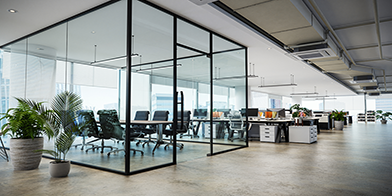Amidst the stress and excitement of finding what appears to be shiny new premises and the inevitable race against time to get the space fitted out, it is important for a tenant to take a step back. Giving careful consideration to exactly what you are taking on and what you might be liable for during the course of the lease is important for long term success.
What are the key issues for tenants to consider?
The starting point where a tenant takes on a lease is ‘caveat lessee’ – in other words, a tenant takes the premises as it finds it, irrespective of the condition and state of repair that it is in. This can have a number of important consequences for a tenant.
Where a lease requires a tenant to keep the demised property in a good state of repair, the tenant could find itself immediately liable for the cost of undertaking any necessary repair work to the premises on completion of the lease.
Similar issues may arise where a lease requires a tenant to contribute through the service charge to the maintenance and repair of the common parts of the building and replacement of M&E (mechanical and electrical) systems. With the Government’s aim to become carbon neutral, landlords are coming under ever increasing pressure through various statutory measures to upgrade their buildings to ensure that they are more energy efficient and comply with the Minimum Energy Efficiency Standards, known as MEES. By April 2025, landlords are required to submit a valid Energy Performance Certificate (EPC) and there is then a two year window for compliance with that obligation.
As a result, landlords have been undertaking a comprehensive review of their buildings to see what measures can be taken to improve their energy efficiency. Examples of measures that can be taken include upgrading insulation and replacing existing glazing and M&E systems - in particular those that are coming to the end of their existing lifecycle and can be replaced with more energy efficient alternatives.
Where the lease permits, a landlord is likely to seek to recover the cost of any capital expenditure from the tenants in the building who are liable to contribute to the replacement costs through the service charge provisions in their respective lease. Typically, service charge provisions will enable a landlord to pass through the costs of replacing machinery and equipment such as lifts, air conditioning and heating systems together with the cost of replacing expensive items such as external cladding/glazing and the communal roof to tenants.
This can result in a tenant having to contribute hundreds of thousands of pounds towards the replacement costs of a particular major item in addition to the yearly service charge costs.
What steps should a tenant take to ensure that it doesn’t find itself responsible for a hefty repair or service charge bill?
The general position regarding the tenant taking the property as it finds it is subject to some important caveats, namely that, where prior to taking the lease, a landlord makes representations to the tenant in relation to the state and condition of the premises or building, which the tenant relies on, and those representations later turn out to be false or inaccurate. In those circumstances, a tenant would, in theory, be able to terminate the lease on the grounds of the landlord’s misrepresentation or, alternatively, claim damages against a landlord.
Before entering into a new lease, a tenant’s solicitor will typically raise various enquiries with the landlord’s solicitor known as Commercial Property Standard Enquiries (or CPSEs for short), which will cover a wide range of issues in relation to the physical condition of the premises, building and also the rights and liabilities affecting the premises. However, whilst the standard form CPSEs will cover whether a particular premises currently has a minimum EPC certificate and what the landlord’s planned maintenance programme and projected expenditure is for the building, this will not necessarily require a landlord to confirm its future intentions for the building. In particular, if a landlord has not yet made a final decision regarding a specific capital expenditure project for the building.
It is therefore important for a tenant to ensure that it raises sufficiently robust and wide-ranging additional enquiries with the landlord in relation to the state and condition of the premises to be demised and the building as a whole. Specifically, regarding the age and condition of the M&E, roof and cladding and whether the landlord is proposing to replace these in the next five years or so. If this is the case, appropriate carveouts should be negotiated in the lease regarding the tenant’s liability to contribute to the full costs of these works.
In addition to this, a tenant should also consider whether it is appropriate to engage a building surveyor to undertake a survey of the premises to be demised and also the common parts/exterior of the building. If it becomes obvious that repair works are required to the premises to be demised, the tenant should consider one of the following options:
- Agreeing on a schedule of condition to be appended to the lease which limits the tenant’s repairing obligation; or
- To see a capital contribution from the landlord towards the cost of the repair works; or
- A commitment from the landlord to undertake the necessary repair works itself.
Taking the above steps will give a tenant peace of mind that it will not be footing a significant repair bill or become liable for unexpected service charge contributions soon after the lease has been agreed.
